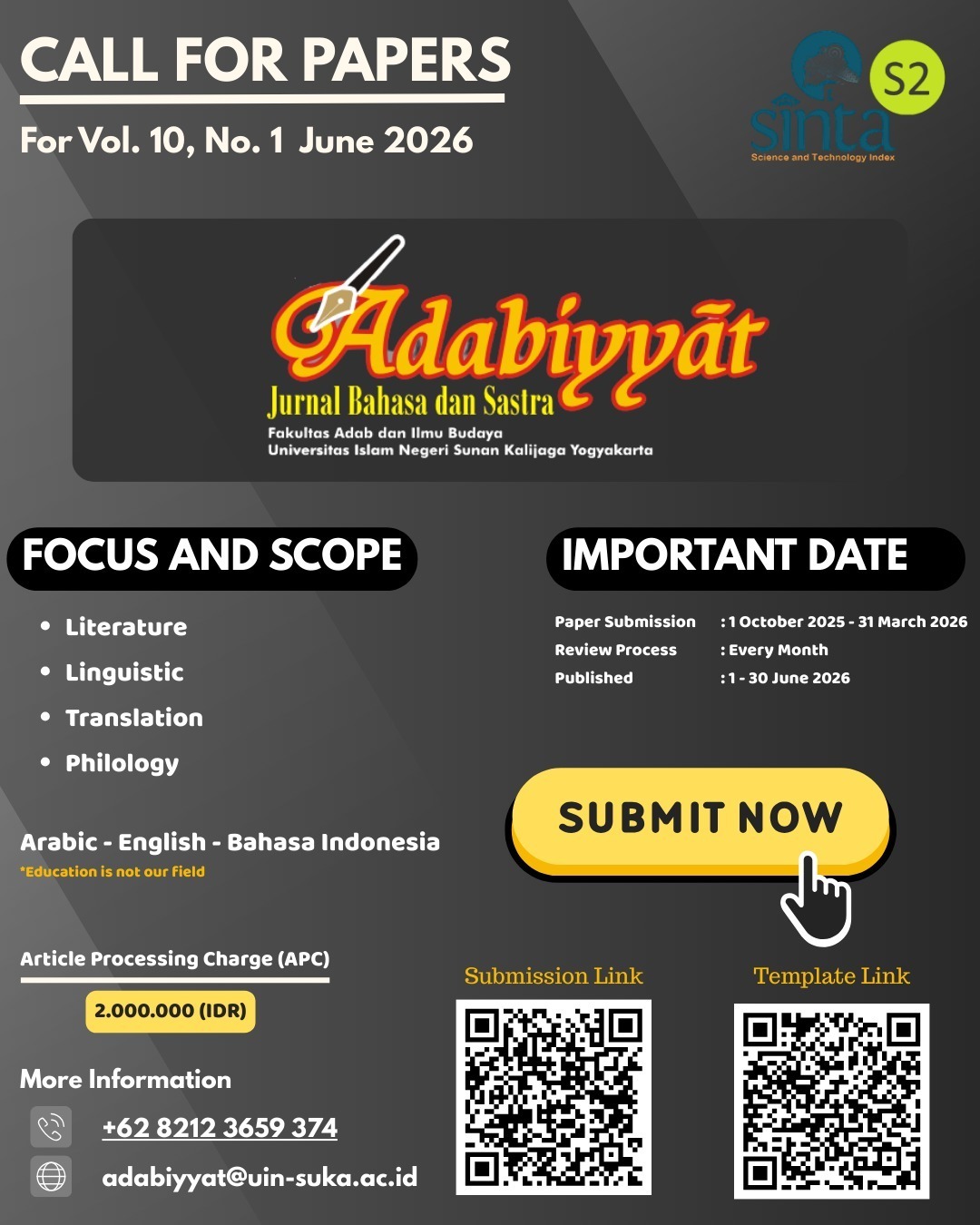ASPEK-ASPEK GRAMATIKAL YANG TERLEWATKAN DALAM PENYUSUNAN TATA BAHASA INDONESIA
DOI:
https://doi.org/10.14421/ajbs.2013.12107Abstract
Many controversial issues on Indonesian grammar need to discuss to be more detail and four of the most crucial ones are: (a) the morphophonemic processes of the active voice marker, (b) the degree of transitivity for the causative and applicative, (c) the third passive other than di- and ter-, and (d) different types of reflexive. The classical Generative Grammar is applied to approach the first issue, while Typological theory is employed for the three other problems. The objective is to propose a new concept on how the grammatical structure is determined. The norm of morpheme for the active voice marker is meng- since it occurs with a wider distribution, while mem-, men-, meng-, me- and menge- occur in particular phonological environments. In the causative –kan and the applicative –i, the -kan is more transitive than the -i. The construction of OAV in this paper is called the third passive, other than the passive di- and ter-. For the reflexive, it has to be distinguished into transitive with a real Object and pseudo Object. The first type can be passived while the second type is not allowed. Reflexive also takes intransitive where the Subject is Doer and Undergoer at the same time.
Downloads
References
Alwi, Hasan., dkk. 2003. Tata Bahasa Baku Bahasa Indonesia (Edisi III). Jakarta: Balai Pustaka.
Dixon, R.M.W. 1994. Ergativity. Cambridge: Cambridge University Press.
Cartier, Alice. 1979. “De-voiced Transitive Verb Sentences in Formal Indonesian”. Dalam Frans Plank (ed.). Ergativity: Towards a Theory of Grammatical Relations. New York: Academic Press.
Chaer, Abdul. 2003. Seputar Tata Bahasa Baku Bahasa Indonesia. Jakarta: Rineka Cipta.
Chung, Sandra. 1976. “On the Subject of Two Passives in Indonesian”. Dalam Charles N. Li (ed.) Subject and Topic. New York: Academic Press.
Chung, Sandra. 1976. “An Object-Creating Rule in Bahasa Indonesia”. Dalam Linguistic Inquiry, Vol 7, Number I.
Comrie, Bernard. 1981. Language Universals and Linguistic Typology. Oxford: Basil Blackwell.
Hopper, Paul J. and Thompson, Sandra A. 1980. “Transitivity in Grammar and Discourse”. Dalam Language 56.
Katamba, Francis. 1993. Morphology. London: The Macmillan Press Ltd.
Kemmer, Suzanne. 1994. “Middle Voice, Transitivity, and the Elaboration of Events”. Dalam Barbara Fox (ed.). Voice: Form and Function. Amsterdam/Philadelphia: johns Menjamins
Kenstowicz, Michael. 1994. Phonology in Generative Grammar. Cambridge & Oxford: Blackwell.
Kentjono, Djoko. Dkk. (eds.). 2004. Tata Bahasa Acuan Bahasa Indonesia. Jakarta: Wedatama Widya Sastra.
Moeliono, Anton. Dkk. (eds.). 1988. Tata Bahasa Baku Bahasa Indonesia (Edisi I). Jakarta: Balai Pustaka. (Cetakan pertama)
Odden, David. 2005. Introducing Phonology. Cambridge: Cambridge University Press.
Pastika, I Wayan. 2011. “Kelemahan Ejaan Bahasa Indonesia yang Disempurnakan secara Fonologis”. Makalah disajikan dalam Kongres Internasional Masyarakat Linguistik Indonesia (KIMLI) di Bandung (9—12 Oktober 2011)
Pastika, I Wayan. 2012. “Klitik –nya dalam Bahasa Indonesia”. Dalam Adabiyyāt Jurnal Bahasa dan Sastra Vol. XX, No. 1, Juni 2012.
Pike, Kenneth. 1968. Phonemics. A Technique for Reducing Languages to Writing. Michigan: The University of Michigan Presss. (Eleventh printing)
Sneddon, James Neil. 1996. Indoenesian Reference Grammar. NSW Australian: Allen & Unwin.
Verhaar, John W.M. 1982. Pengantar Linguistik. Jogyakarta: Gadjah Mada University Press.
Verhaar, John W.M. 1990. “How Transitive is Intransitive”’. Dalam Studies in Language 14.1.
Downloads
Published
Issue
Section
License
- Adabiyyāt: Jurnal Bahasa dan Sastra publishes all articles entirely in full text.
- It is permissible for readers to download and to use it for scientific purposes and scientific dissemination.
- The author can re-publish the article that has been published by the Adabiyyāt: Jurnal Bahasa dan Sastra after obtaining written permission from the editor. This letter can be obtained by submitting a request letter for permission to republish the article to Adabiyyāt: Jurnal Bahasa dan Sastra via email adabiyyat@uin-suka.ac.id. In the second publication, the author is required to include information that the article was firstly published by the Adabiyyāt: Jurnal Bahasa dan Sastra.









